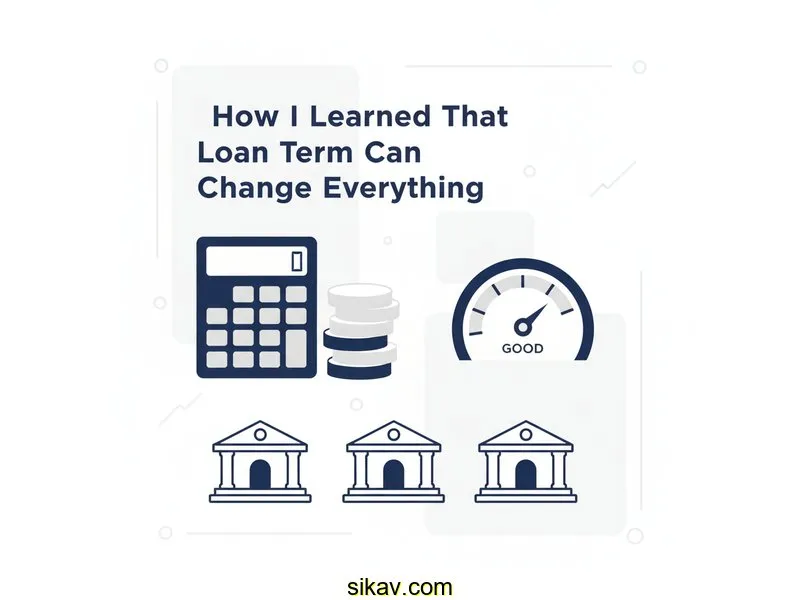
Auto Loan Calculator
Calculate payments over the life of your Loan
Home Blog Privacy Terms About Contact
Calculate payments over the life of your Loan
Home Blog Privacy Terms About ContactPublished on October 14, 2025

My journey into the weeds of loan math started with a simple, almost casual, question. I was looking at hypothetical loan scenarios for a home improvement project and saw two options for the same amount. One had a lower monthly payment, but a longer repayment period. My first thought was, "Well, the lower payment is obviously the better deal. It's more manageable." But a nagging feeling told me it couldn't be that simple. How could paying less each month possibly be the whole story?
What was the actual, tangible difference in cost between paying something off in four years versus five? Was it a few dollars? A few hundred? I had no frame of reference. This wasn't about making a financial decision; it was about pure curiosity. I wanted to understand the mechanics behind the numbers. Why would one option feel easier on my monthly budget but potentially cost more in a way I couldn't see?
My first attempts were clumsy. I found a basic online calculator and plugged in the numbers. It dutifully spat out the monthly payment, confirming what I already knew: the longer-term loan had a smaller monthly bill. But that's all it showed me. There was no "total cost" button, no summary of interest, just that one, lonely number. It felt like reading a single chapter of a book and trying to guess the ending. I knew I was missing the most important part of the narrative.
This is where my real learning began. I realized that to answer my question, I needed to look beyond that single monthly payment figure. I had to figure out how to calculate the entire cost of borrowing. This article is simply a log of that discovery process. It’s about my journey to understand how calculations work and how to use the tools available. It is absolutely not financial advice, but rather a chronicle of one person's quest for calculation literacy.
My initial confusion was rooted in focusing on the wrong number. I was fixated on the monthly payment because it's the number you feel every month. It's tangible. The total cost, on the other hand, felt abstract and distant. To get concrete, I created a specific scenario to explore.
Let's say I was looking at a hypothetical loan for $14,650 at an interest rate of 6.8%. I wanted to compare two different repayment timelines, or "terms."
When I plugged these into a simple calculator, the results seemed to confirm my initial bias. Scenario A, the 60-month term, gave me a monthly payment of around $287.19. Scenario B, the 48-month term, resulted in a monthly payment of $349.33. My brain immediately told me, "$287 is less than $349. It's the more affordable option."
This is where I got stuck. I tried to do the math myself to understand the total cost, but my approach was flawed. I thought, "Okay, for the 60-month loan, I'll pay $287.19 for 60 months." So, I multiplied them: 60 x $287.19 = $17,231.40. Then I did the same for the 48-month loan: 48 x $349.33 = $16,767.84. When I looked at those two totals, a lightbulb flickered on. The "cheaper" monthly payment actually resulted in a higher total amount paid over the life of the loan. But why?
The simple calculator hadn't shown me this. It hadn't highlighted the most crucial piece of information: the total interest. It was my own multiplication that revealed the discrepancy, but I didn't understand the underlying mechanics. I couldn't grasp how an extra year of payments, even smaller ones, added up to so much more in interest. The frustration was real. I knew there was a mathematical principle at play that I was completely missing. The calculator was giving me answers, but it wasn't giving me understanding.
My "aha moment" came when I stumbled upon a more advanced online loan calculator. This one wasn't just a single field for the loan amount and another for the term. It had a whole dashboard of outputs: Monthly Payment, Total Principal Paid, Total Interest Paid, and a beautiful, detailed amortization schedule. That "Total Interest Paid" field was the key that unlocked everything.
Instead of just seeing the monthly payment, I could now directly compare the true cost of borrowing for my two scenarios. When I entered the same numbers—$14,650 at 6.8%—the calculator laid it all out with perfect clarity. It performed the same multiplication I had just done, but it presented it in a way that made the lesson sink in. It explicitly labeled the difference between the loan amount and the total paid as "interest." Seeing that word attached to a specific dollar amount changed my entire perspective.
The advanced calculator didn't just give me the answer; it gave me the tools to understand it. Here’s what I pieced together.
The core concept I had missed is that interest is calculated on the remaining balance. With a longer loan term (60 months), the principal balance decreases more slowly than with a shorter term (48 months). This means for a longer period, you are paying interest on a larger outstanding balance. Those extra 12 months weren't just 12 more payments; they were 12 more instances of interest being calculated on a still-significant loan amount.
This was the most illuminating part. I clicked "Show Amortization Schedule" and saw a table with 60 rows. For the first payment of $287.19, a whopping $83.02 went to interest, and only $204.17 went to reducing the principal. By contrast, in the 48-month loan's first payment of $349.33, the same $83.02 went to interest, but $266.31 went to principal. Seeing that side-by-side proved that the shorter-term loan attacked the principal more aggressively from the very first payment.
To make sure I really got it, I ran a completely different scenario. I imagined a smaller loan of $9,200 at a 7.5% interest rate. This time, I compared a 36-month term to a 24-month term. As I predicted, the 36-month term had a lower monthly payment (around $285) but a higher total interest cost (about $1,061). The 24-month term had a higher payment (around $414) but a lower total interest cost (about $727). My hypothesis was correct! The relationship between term and total interest held true. It wasn't magic; it was math.
This whole experience was incredibly empowering. It wasn't about choosing a loan; it was about finally understanding the language the numbers were speaking. Here are the main calculation-focused lessons I took away from my little research project:
As I went through this process, I had a lot of questions. Here are some of the key ones I found answers to, framed from a purely educational standpoint.
The loan term is a key input in the loan payment formula. A longer term (more months) means you are dividing the total principal and interest over a larger number of payments. This mathematical division naturally results in a smaller amount for each individual payment, but it also provides more opportunities for interest to accrue on the outstanding balance.
This is because of how amortization works. Interest is calculated each month based on the current outstanding principal. In the beginning, your principal balance is at its highest, so the interest portion of your payment is also at its highest. As you pay down the principal, the amount of interest calculated each month decreases, so a larger portion of your fixed payment can go toward the principal.
The most straightforward way is to first calculate your total payments by multiplying your monthly payment by the number of months in your loan term (e.g., $300/month x 60 months = $18,000 total paid). Then, you subtract the original loan amount (the principal) from that total. The remaining amount is the total interest paid (e.g., $18,000 total paid - $15,000 principal = $3,000 total interest).
From my learning journey, the most insightful field for comparing the true cost of two different loan structures (especially with different terms) is the "Total Interest Paid." While the monthly payment tells you about your cash flow, the total interest tells you the ultimate cost of borrowing the money.

My biggest takeaway from this whole exercise was a simple but profound one: the lowest monthly payment doesn't automatically equal the cheapest loan. It was a revelation that came not from a textbook or a lecture, but from my own curiosity and willingness to play with the numbers in an online calculator. By focusing on the "Total Interest Paid," I found a much clearer way to understand the long-term financial mechanics of a loan.
I feel more confident now, not in making decisions, but in understanding the information presented to me. It's a great feeling to know that the math isn't scary; it just tells a story. Taking the time to learn how to read that story is a skill I believe anyone can develop. It just takes a little curiosity and a good calculator.
This article is about understanding calculations and using tools. For financial decisions, always consult a qualified financial professional. My journey is about learning the 'how' and 'why' behind the numbers, and I hope sharing it helps demystify the process for others who are just as curious as I was.
Disclaimer: This article documents my personal journey learning about loan calculations and how to use financial calculators. This is educational content about understanding math and using tools—not financial advice. Actual loan terms, rates, and costs vary based on individual circumstances, creditworthiness, and lender policies. Calculator results are estimates for educational purposes. Always verify calculations with your lender and consult a qualified financial advisor before making any financial decisions.
